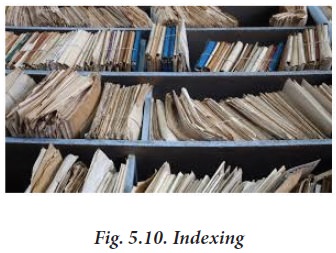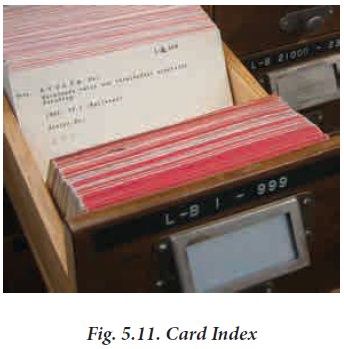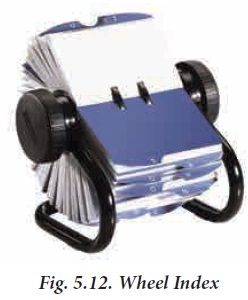Systems or Methods or Types of Indexing, Advantages, Merits, Demerits, Selection | Office Indexing - Indexing | 11th Office Management and Secretaryship : Chapter 5 : Filing and Indexing
Chapter: 11th Office Management and Secretaryship : Chapter 5 : Filing and Indexing
Indexing
Indexing:
Index
is anything that “points out” or indicates. Indexing can be described as a
method of providing indicators for a body of data or collection of records. The
term “indexing” should not be confused with the term “classification”.
Classification is the method of filing while indexing is basically the method
used for making reference to the matter filed.

Objectives of Indexing:
The
principal objective of indexing is to assist filing so that filed papers are
located easily and quickly whenever they are needed. Indexing thus adds to the
efficiency of the filing method. It ensures speed and consequently economy
results due to increased speed. The objective of indexing is best achieved
where the right type of indexing system is chosen. Where files are arranged in
geographical-cum-alphabetical or only alphabetical order, an index is not
needed. However, in other systems of classification, it becomes essential to
provide an index for customers, suppliers, credit ratings telephone numbers and
soon. Index is also required for different kinds of registers and ledgers.
Essentials of a Good system of Indexing:
In
order to achieve its objectives, a good system of indexing should have the
following essential features;
1.
It
should be simple.
2.
It
should be economical in operation.
3.
It
should allow for speed.
4.
It
should go well with the system of filing in the organization.
5.
It
should be flexible to allow for expansion when needed.
Advantages of a Good System of Indexing:
A
good system of indexing, i.e., which goes well with the filing methods in the
organization, offers the following benefits in the field of records management.
1.
Easy Location: The required papers and documents are located very easily with the help of their index.
Referencing is not a painful process.
2.
Easy
Cross-Referencing: A good system of indexing also
ensures easy cross-referencing and thus saves on time and botheration.
3.
Lower Costs: The operating costs of records administration are also low due to improved efficiency of
the records administration. Time is not wasted in locating the necessary
documents or papers.
Systems or Methods or Types of Indexing
Indexing
may be classified into the following main categories, namely: (a) Page Index;
(b) Card Index and (c) Visible Index.
a. Page or Book Index:
This system is also known as alphabetical indexing as classification is based on
the letters of the alphabet. One page or leaf is allotted for each letter of
alphabet, fitted with a tab showing the letter and quoting the relevant page numbers.
The pages may be held in a loose form or in a bound book form. Each page consists of a list
of all the correspondents whose names begin with the letter to which that page
or sheet is allotted. For example, all names beginning with the letter ‘A’ like
Anuradha, Anandhi, Akila will be written on the page allocated to the letter
‘A’. The folder number of correspondents relating to a particular person will
appear against his/ her name.
![]()
Page
Index may take the form of either (1) Bound Book Index (2) Loose Leaf Book
Index and (3) Vowel Index. These are described below:
i. Bound Book Index: It is in the form of bound book or register which is divide
into alphabetical sections where in the names of persons are entered.
Each
section has the leaves cut way at the right hand side so that the initial
letters of all the sections are visible at a glance. The book index is very
cheap and is a good long time record. The pages cannot be lost or disarranged
because they are bound. This is an inflexible method since alterations are
difficult and it accommodates a comparatively less number of entries. Example:
Telephone Index.
ii. Loose leaf Book Index (or)
Vertical Card Index: Loose
sheets are used for indexing and the
fastened are metal rings or hinges or some other device which allows the pages
to be taken out and also helps in insertion of additional pages. This type of
index is also fitted with a lock. It is very much used by the commercial banks
and the joint stock companies for keeping the records of their customers,
shareholders and debenture holders.
Loose
Leaf Indexing is flexible and adaptable to different users. It offers ample
scope for expansion with the main drawback of loss or damages.
Merits of Page or Book Index:
·
It
is very cheap and simple method.
·
It
requires less space.
·
It
can be carried from one place to another.
Demerits of Page or Book Index:
·
A
strict alphabetical arrangement of names on each page may not be possible.
·
Names
must be deleted once they are no longer of any use. This may present a shabby
appearance.
·
It
is an inflexible system of indexing, scope for further entries even in case of
loose leaf index is limited.
iii. Vowel Indexing: In case where the number of correspondents is very large
the alphabetical indexing is further classified. The names of the
correspondents are entered on one page or the other according to the letter
with which his name begins and first vowel in his name. This sort of indexing
is known as “Vowel Indexing”. E.g. AShika the first vowel in the name is “I”.
It will be classified under “Ai”
(b) Card Index: Under this method references are entered on the cards of uniform size. These cards bear the
names, number of the files and other particulars to be indexed. Cards are
arranged in either alphabetical or numerical order and are place in drawers or
boxes which may have a rod running from one ending to the other end for holding
cards in their places. These drawers are divided into alphabetical sections by
means of guide cards.

The
purposes for which card index may be used are listed below.
·
As
catalogue of books in library;
·
To
contain specimen signatures of customers in bank.
·
To
contain addresses and other particulars of customers;
·
To
maintain accounts of store items;
·
To
maintain history of employees;
·
To
keep records of installment sales.
Merits of Card Indexing System:
·
The
cards provide a complete list of the names, addresses and telephone numbers of
the persons or the firms with whom the dealings take place.
·
Each
card may be ruled according to the particulars desired to be recorded.
·
Ready
information is available for different purposes, e.g., for knowing the number
of customers in a particular territory.
·
It
has greater flexibility because the number of cards can be increased or
decreased as desired. Cards may be grouped and re-grouped in any manner and in
any order.
·
The
index is always alive since the dead cards are removed and transferred to dead
cabinets.
·
Card
index can be used by a number of persons at the same time.
Demerits of Card Index system:
·
There
is danger of separate cards being lost by the persons who take them away from
the drawers for reference.
·
Ready
reference may be difficult if the cards are allowed to be removed freely from
the drawers.
·
Card
index is blind since cards are not visible at a glance.
·
Card
indexing is comparatively costlier than page indexing.
·
Card
gets torn or spoiled through constant handling. Thus, they have to be replaced
from time to time.
·
Cards
may be substituted to commit or to conceal fraud where card ledgers are kept.
![]()
Despite
these drawbacks, the system of card indexing is very elastic and simple to
operate and so is used frequent by libraries, hospitals, banks (for maintaining
specimen signature) and other offices (to keep credit records, staff records
and so on).
(c) Visible Index:
The
major defect of card indexing is that a large number of cards cannot be seen at
one glance. This defect is overcome by visible indexing under which a large
number of cards are visible at one glance. Visible card index, strip index and
wheel index are the systems of visible indexing.
1. Visible Card Index:
Visible card index system has gained more popularity in recent years. It is based on
the principle “look at the card, not for it”. Visible card indexing can be used
for retaining records such as accounts receivable, personal history of
employees and specimen signatures of customer in a fairly permanent position
for frequent reference. The speed in which the cards can be located and the
necessary entries made, justifies the use and cost of visible card filing
equipment.
The
main feature of visible filing is that the main reference (i.e. the main
information) on each card is visible at all times. The cards are arranged in
such a way that it overlaps the one before it leaving a narrow strip at the
bottom containing the name, telephone number of the subject visible.
Merits of Visible Card Index:
·
Speedy
reference is possible as the names of the customers or subject are all visible.
·
Though
visible indexing costs more,
·
it
saves time and labour much that it offsets the additional cost.
·
Additional
information can be easily written on the cards even without disturbing the
order in which they have been kept.
·
Cards
can be removed and inserted with great ease.
·
Visible
card indexing is very compact as a large number of cards can be accommodated in
every tray.
Demerits of Visible Card Index:
·
The
visible card index equipment is costlier than the equipment required for card
index.
·
The
filing staff must be trained properly for its operation.
2. Strip Index:
It
is a type of visible indexing which is used when the entries are limited to a
few lines (names, addresses, etc ;). It consists of a frame into which strips
of stiff paper can be fixed in any required order. Each strip is devoted to one
name only. Frames containing these strips may be either fixed on the wall or
arranged on a rotary stand which can be turned round to look at any part of the
index. These strips can be protected from exposure or damage by using removable
transparent celluloid covers.
3. Wheel Index:
It
is an improvement over visible card index. Cards are arranged about the
circumference of the wheel. A single wheel can hold as many as 1000 cards.
Cards can be inserted into or taken out of the slits of the metal rod whenever
needed. An entry can be made on the card by applying the brakes to keep the
wheel fixed. Thus, entries can be made on the cards and cards can be referred
to without removing them from the wheel.

Merits of Wheel Index:
·
Wheel
index makes reference very easy and quick. It saves time and efforts.
·
It
is economical in space as a large number of cards can be accommodated in a
wheel.
·
Entries
can be made on the cards without removing them from the wheel.
·
New
cards can be added and old ones removed without much difficulty. Thus wheel
index allows flexibility in operations.
Selection of a Suitable Indexing System:
Every
system of indexing has its own merits and demerits. Some methods are rigid
while others are flexible through expensive. The installation of a suitable
indexing system depends mainly on the following factors.
1.
The
type and extent of information needed.
2.
The
cost of equipment in each system.
3.
The
cost of labour in each system.
4.
The
space required for each system.
5.
The
frequency of adding or deleting.
6.
The
purpose of using an index
Related Topics